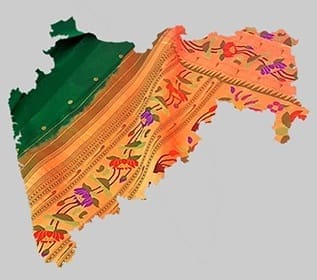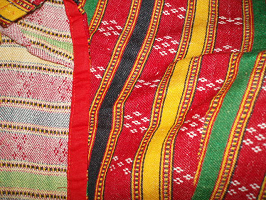Traditional Indian Textiles – Appreciating and preserving the heritage
Special focus: Traditional Textiles of Maharashtra
The textiles of each state in India speak volumes about their cultural heritage. Unfortunately, despite the versatility of the fabrics and their eco-friendly production process, many Indian threads and works of embroidery are fading and becoming dying arts. These techniques add aesthetic value to a fabric or a garment affirms Nitika Rana.
India has a diverse and rich textile tradition. It has a wide range of textiles of varied designs, manufactured by different techniques as compared to other countries of the world. The specialty in the weave of the textiles in each region is developed based on location, climate and cultural influences. In addition to being beautiful, Indian fabrics are the most suited to the Indian climate. The weaves are often colourful, and fabrics are often worked over with incredibly intricate embroidery.
The origin of Indian textiles can be traced to the Indus valley civilization. The people of that civilization used homespun cotton for weaving their garments. Excavations at Harappa and Mohenjodaro, have unearthed household items like needles made of bone and wooden spindles, suggesting that the people would spin cotton at home to make yarn and finally garments. Fragments of woven cotton have also been found at these sites.
The first literary information about textiles in India is available in the RigVeda, which refers to weaving. The ancient Hindu epics, the Ramayana and the Mahabharata mention a variety of fabrics in vogue during those times.
India had numerous trade links with the outside world and Indian textiles were popular in other countries of the ancient world. Indian silk was popular in Rome in the early centuries of the Christian era. Cotton textiles were also exported to China during the heydays of the silk route. Silk fabrics from south India were exported to Indonesia during the 13th century. India also exported printed cotton fabrics / chintz to Europe and the Asian countries like China, Java and the Philippines, long before the arrival of the Europeans.
In the 13th century, Indian silk was used as barter for precious commodities from the western countries. Towards the end of the 17th century, the British East India Company traded in Indian cotton and silk fabrics which included the famous Dacca (Bengal) muslin besides substantial quantities of the same fabric made in Bihar and Orissa. The past traditions of the textile and handlooms is still discernible in the motifs, patterns, designs, and weaving techniques, employed by the weavers even today.
Materials used:
Dyes
Earlier only natural dyes were used. There are over 300 dye-yielding plants in Indian subcontinent. Commonly used natural dyes include yellow from the palash (flame of the forest) and kusum flowers, red pollen dust of the rora flower and the deep rose red from lac,. Other dye-yieding plants are Dhaniya (light green), Mas (deep blue), Kariya (black), Anchi (deep purple), Jamalla (purple), Darra (deep rose red), Katha (maroon), Narangi (orange), Rani (deep Indian pink), Phiroza (turquoise), etc.
The secret of the fast colouring of vegetable lies in sensitive and intelligent use of metal oxides as an intermediary substance, known as mordant.
Fabrics
Cotton and silk are the mostly widely used fibres in traditional fabrics like kanjivaram sarees, pochampalli, etc. Handloom fabrics like khadi are also quite popular.
Techniques:
Handwoven/Handloom textiles
Most of Indian weaves are weft faced.
Shawls of Kashmir are produced on heddle looms. Kashmiri shawls are also embroidered.
Brocade of banaras use zari yarns to produce heavy wedding sarees. Kanjivaram and Pochampally sarees are popular in South India. Jamdani sarees are produced in eastern part of India. Paithani sarees are woven in maharshtra. Each variety of saree has unique designs and colours. The yarn count also varies varying the density of fabric.
Khadi fabric is a handloom fabric made from handspun pure cotton/sometimes silk yarn.
Resist dyeing
Tie and dye is a traditional technique of tying fabric with threads and producing an array of designs like bandhani, leheria, etc. It is popularly used in Rajasthan and Gujrat. The colors used distinguish the fabrics produced in these states. A variety of products like dupattas, ghagra choli, turbans, etc. are made from these colourful fabrics. Patola and Mashru are popular fabrics of Gujrat and Rajasthan, in which dyed warp and weft are used to manufacture expensive saris and turbans.
Batik is another resist dyeing technique in which wax is used as a resist and cold dyeing is done to apply dyes. Wonderful patterns are produced by the natural cracking of wax and different products like bedsheets, kurtis, sarees, etc. are produced from them.
Ikat textiles are created from tie and dyed yarns in Orissa, Gujrat and Andhra Pradesh.
Printing and Painting
Handblock printing is used to produce patterns using wooden blocks on fabrics that can be used in both apparel as well as furnishings in Rajasthan as well as Gujrat. There are two styles of block printing – Sanganeri and Bagru
Kalamkari is a handpainting technique popular in Andhra Pradesh. Special kalam is used to create intricate motifs.
Embroidery
Embroidery is a surface ornamentation technique that can turn a dull piece of fabric into a piece of art.
Be it Phulkari of Punjab or chamba rumal of Himachal, Chikankari of Uttar Pradesh or Kantha of Bengal, Mirror work of Rajasthan or Ari work of Gujrat, Kasuti of Karnatka or kashida of Kashmir, each embroidery in India is based on a unique set of motifs which are used with a special set of coloured threads on specific fabrics like khaddar is used for phulkari, voile is popular for chikankari and kasuti embroidery is done on coarse fabrics.
From the Rann of Kutch to the Coromandel Coast, and from the deserts of Sind and Baluchistan to the North-West frontier, the handloom weavers, block printers, textile painters, dyers and embroiderers work to develop traditions of textile crafts in India. These textiles add value to Indian fabrics and stand out in the world because of their unique and attractive characteristics.
Traditional textiles of Maharashtra
Maharashtra produces a variety of textiles. These include paithani sarees from paithan and Aurangabad, himroo and mashru textiles from Aurangabad, brocades form pune and nasik and handblock printed fabrics form vidarbha region.
Handblock printing is majorly done in Vidarbha region of Maharashtra by the Bavasars community. Natural colours are used and the main products are bedcovers, quilts,etc.
Mashru is a satin weave fabric in which warp is silk yarns and weft is cotton yarns. This fabric is particularly worn by muslims as they are forbidden to wear pure silk next to skin. Paithan and Aurangabad are famous centres for producing mashru fabrics.
Himroo is similar to mashru, made of silk and cotton, but it is much finer in texture. These fabrics are used as bridal robes, veils and in saris too. It is also more expensive than mashru.
Paithani is the most famous and most costly maharashtrian textile which is used in making sarees. Pithani weaving is majorly done at Aurangabad and in Paithan regions of Maharashtra.
Paithani sarees
Paithani is the costly high quality silk gold embroidered sari named after the Paithan town in Aurangabad. It is also known as ‘Mahavastra’ & is one of the most popular saris of Maharashtra.
The art of weaving Paithani flourished in 200B.C., during Satvahana era. Production of Paithani soon spread in other places like Yeola, Pune, Nasik and Malegaon apart from Paithan. The traditional designs of paithani are mostly derived from old Mughal miniatures, Ajanta caves, Buddhist paintings, etc.
Technique of manufacturing
Tapestry techniques of weaving patterns is applied with gold and silk threads to make paithani sarees. About 4 – 24 shuttles are employed to produce the design. It is a slow and laborious work. It may take up to 8 days to produce one sq. ft. of fabric by this technique. It takes months to upto 2 years to manufacture a paithani saree on traditional handlooms.
Traditional motifs of paithani
A traditional Paithani has plain body and a pallu with tiny motifs called ‘buttis’. These buttis have various shapes like coin, flower, peas, star, etc.
The main motifs of paithani are peacock, parrot, lotus, paisley, flowers, leaves, creepers & their variations.
Nachara Mor (Dancing Peacock)
Bangadi Mor (Four Peacocks in Bangle)
Paired Sitting Peacock
Narali (Coconut) Border
Tota-Maina (Parrot & Muniya)
Asavali Mandap (Flower Vase and Vine)
Popular Colours
Generally, bright and dark colours are used in making paithani sarees. Local names of colors are like chandrakala for black, neelgunji for blue, shirodak for white, kusumbi for violet red, raghu for parrot green, motiya for pink, etc.
Cost
Paithani sarees are associated with royalty as they are made from zari with detailed workmanship. Due to this, these sarees are very expensive ranging from Rs. 8000 to Rs. 5 lakh for heavier brocades.
Other uses of Paithani textiles
The use of paithani textile is being diversified to make waistcoats, pouches, wall hangings and even women’s salwar suits.
This column will take you through a journey of the textile arts of India that give us a competitive edge in the global market. Awareness about this rich heritage of India can direct many to add value to their textile products.
Author :

Nitika Rana, is a B.Tech. in Textile Technology and an MBA. She has also done a specialized course in Traditional Embroideries of India. She is currently working as Adjunct faculty at IAM, Mumbai. [email protected]
References
Indian Textiles by John Gillow and Nicholas Barnard
The Sari by Linda Lynton
Traditional Textile by John Gillow and Nicholas Barnard
Indian Saris by Vijai Singh Katiyar
https://www.yarnsandfibers.com/
https://www.indiaheritage.org/creative/creative_textiles.htm
https://www.fashionablydesi.com/
https://www.craftandartisans.com/textiles-of-maharashtra.html
https://www.maharashtratourism.gov.in/
https://www.hoparoundindia.com/maharashtra/local-info-of-paithan.aspx
https://www.touchofclass.co.in/














